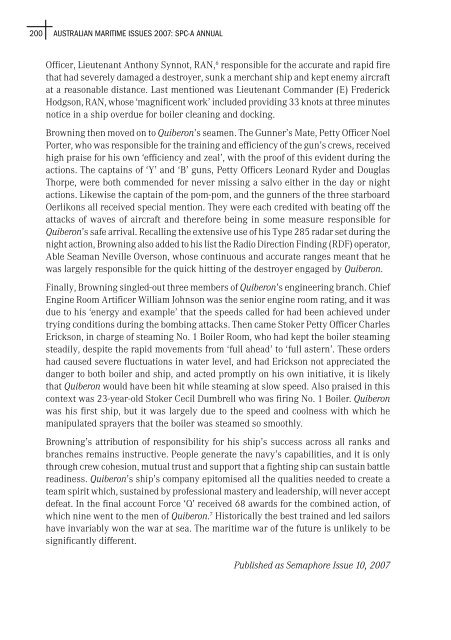Australian Maritime Issues 2007 - Royal Australian Navy
Australian Maritime Issues 2007 - Royal Australian Navy
Australian Maritime Issues 2007 - Royal Australian Navy
Create successful ePaper yourself
Turn your PDF publications into a flip-book with our unique Google optimized e-Paper software.
200 AUSTRALIAN MARITIME ISSUES <strong>2007</strong>: SPC-A ANNUAL<br />
Officer, Lieutenant Anthony Synnot, RAN, 6 responsible for the accurate and rapid fire<br />
that had severely damaged a destroyer, sunk a merchant ship and kept enemy aircraft<br />
at a reasonable distance. Last mentioned was Lieutenant Commander (E) Frederick<br />
Hodgson, RAN, whose ‘magnificent work’ included providing 33 knots at three minutes<br />
notice in a ship overdue for boiler cleaning and docking.<br />
Browning then moved on to Quiberon’s seamen. The Gunner’s Mate, Petty Officer Noel<br />
Porter, who was responsible for the training and efficiency of the gun’s crews, received<br />
high praise for his own ‘efficiency and zeal’, with the proof of this evident during the<br />
actions. The captains of ‘Y’ and ‘B’ guns, Petty Officers Leonard Ryder and Douglas<br />
Thorpe, were both commended for never missing a salvo either in the day or night<br />
actions. Likewise the captain of the pom-pom, and the gunners of the three starboard<br />
Oerlikons all received special mention. They were each credited with beating off the<br />
attacks of waves of aircraft and therefore being in some measure responsible for<br />
Quiberon’s safe arrival. Recalling the extensive use of his Type 285 radar set during the<br />
night action, Browning also added to his list the Radio Direction Finding (RDF) operator,<br />
Able Seaman Neville Overson, whose continuous and accurate ranges meant that he<br />
was largely responsible for the quick hitting of the destroyer engaged by Quiberon.<br />
Finally, Browning singled-out three members of Quiberon’s engineering branch. Chief<br />
Engine Room Artificer William Johnson was the senior engine room rating, and it was<br />
due to his ‘energy and example’ that the speeds called for had been achieved under<br />
trying conditions during the bombing attacks. Then came Stoker Petty Officer Charles<br />
Erickson, in charge of steaming No. 1 Boiler Room, who had kept the boiler steaming<br />
steadily, despite the rapid movements from ‘full ahead’ to ‘full astern’. These orders<br />
had caused severe fluctuations in water level, and had Erickson not appreciated the<br />
danger to both boiler and ship, and acted promptly on his own initiative, it is likely<br />
that Quiberon would have been hit while steaming at slow speed. Also praised in this<br />
context was 23-year-old Stoker Cecil Dumbrell who was firing No. 1 Boiler. Quiberon<br />
was his first ship, but it was largely due to the speed and coolness with which he<br />
manipulated sprayers that the boiler was steamed so smoothly.<br />
Browning’s attribution of responsibility for his ship’s success across all ranks and<br />
branches remains instructive. People generate the navy’s capabilities, and it is only<br />
through crew cohesion, mutual trust and support that a fighting ship can sustain battle<br />
readiness. Quiberon’s ship’s company epitomised all the qualities needed to create a<br />
team spirit which, sustained by professional mastery and leadership, will never accept<br />
defeat. In the final account Force ‘Q’ received 68 awards for the combined action, of<br />
which nine went to the men of Quiberon. 7 Historically the best trained and led sailors<br />
have invariably won the war at sea. The maritime war of the future is unlikely to be<br />
significantly different.<br />
Published as Semaphore Issue 10, <strong>2007</strong>
















